On View
Pay Attention to the Loaded Details in Artist Robert Pruitt’s Powerful Images of Devotion
At the California African American Museum, the Houston-based artist's "Devotion" explores the meeting of different time periods and traditions.
![Robert Pruitt Creator and Redeemer [detail] (2016). Courtesy the artist and Koplin Del Rio Gallery. Robert Pruitt Creator and Redeemer [detail] (2016). Courtesy the artist and Koplin Del Rio Gallery.](https://news.artnet.com/app/news-upload/2018/10/devotion-detail-robert-pruitt-1024x706.jpg)
At the California African American Museum, the Houston-based artist's "Devotion" explores the meeting of different time periods and traditions.
![Robert Pruitt Creator and Redeemer [detail] (2016). Courtesy the artist and Koplin Del Rio Gallery. Robert Pruitt Creator and Redeemer [detail] (2016). Courtesy the artist and Koplin Del Rio Gallery.](https://news.artnet.com/app/news-upload/2018/10/devotion-detail-robert-pruitt-1024x706.jpg)
Colony Little

In “Devotion,” Robert Pruitt’s latest exhibition at the California African American Museum, the subjects of his portraits are all looking at something or someone beyond the picture plane. Their gaze is focused and discerning as they assess something that’s happening or is about happen. Their place in time is unknown. The uncertainty that these figures convey only intensifies as small details in the drawings begin to reveal themselves.
This show marks the Houston-born artist’s first major solo museum exhibition in Los Angeles. For it, Pruitt is out to weave the past, present, and future together, positing that different time periods intersect within the same artistic moment.
In these large drawings, the artist visually imagines this theory come to life, fusing elements of pre-colonial Africa, pop culture, science fiction, and Afrofuturism.
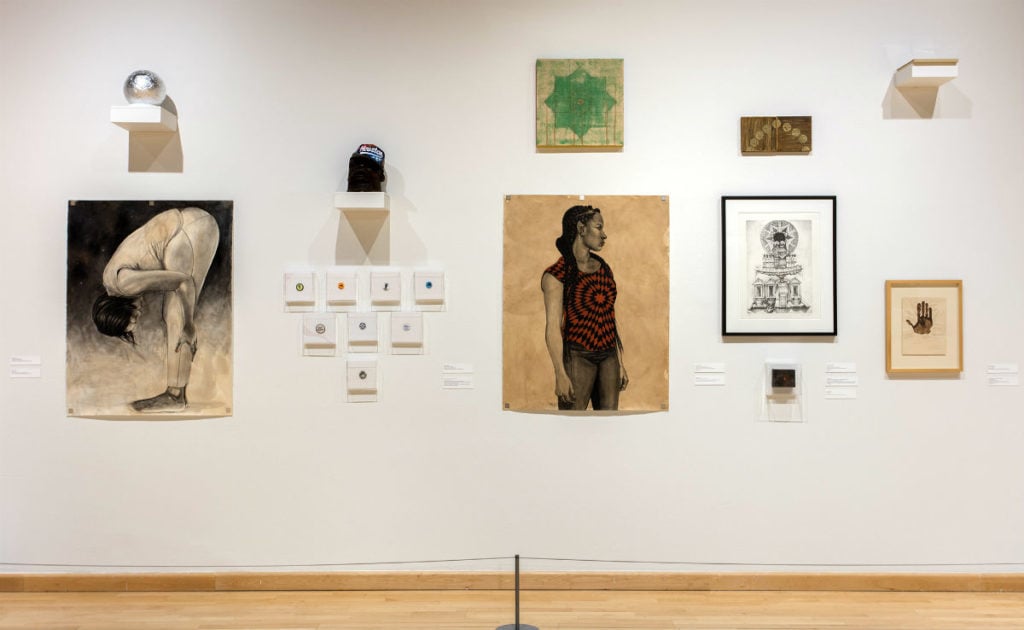
Installation View of “Devotion” at CAAM. Photo by Brian Forrest.
Religious themes become the symbolic ties that bind time periods together. The black church has historically played a prominent role in catalyzing social change and shaping African American identity, and in “Devotion,” Pruitt’s subtle use of religious iconography manifests in his figures’ adornment.
Thus, in a piece called Communion, two women are styled in perfectly coiffed 1990s hairstyles, topped with red paisley handkerchiefs resembling church hats or fascinators. A nameplate necklace worn by one of the women reads, “This do in remembrance of me,” referencing a Bible verse. The “what” or “who” being remembered in this specific image remains unclear.
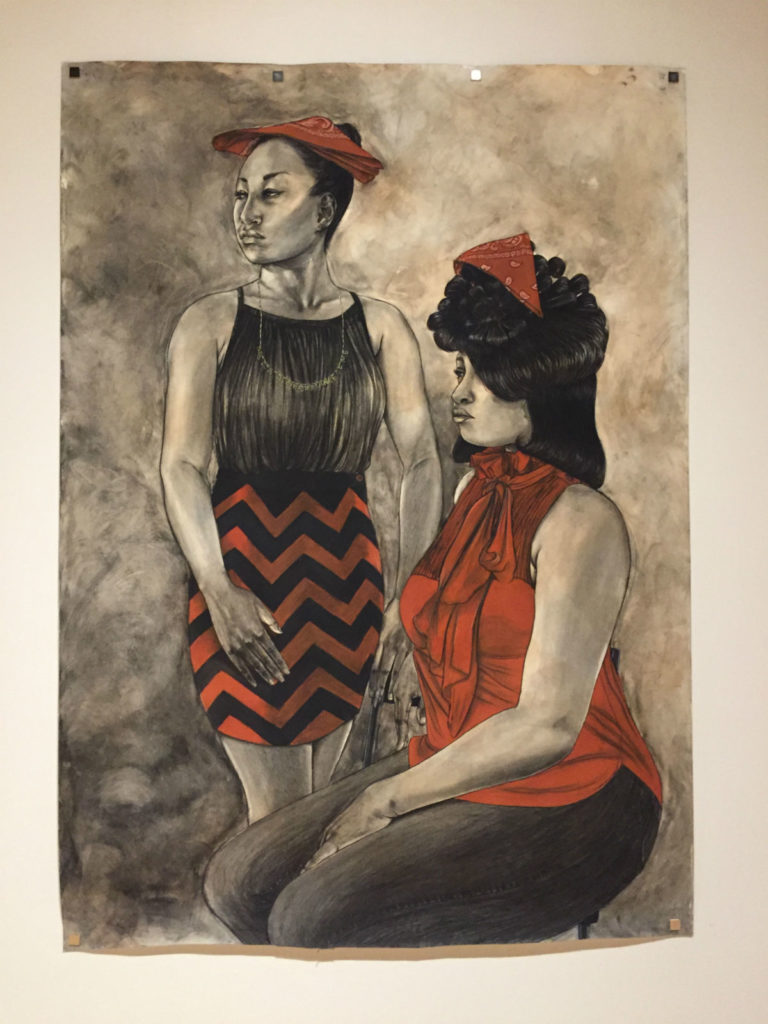
Robert Pruitt, Communion (2018). Photo by Colony Little.
Yet while this scene initially suggests religious fellowship, the somberness and stoicism on the subjects’ faces gives an uneasy hint of danger—and looking closer, you find further suggestions of it. A razorblade is placed in one of the women’s hands, a small detail that alters the entire tone of the work and points to a whole new context.
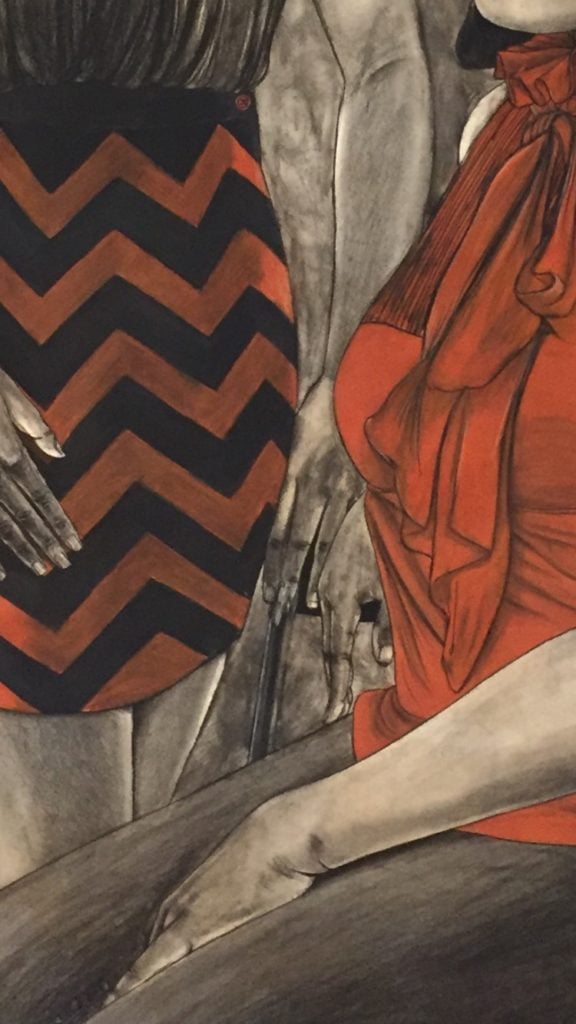
Detail showing the razor in Robert Pruitt, Communion (2018). Photo by Colony Little.
Communion’s wall text mentions religion as a reference, but also gang life, two poles of societal kinship that are both characterized by ceremony and visible signs of respect. Pruitt’s use of the color red, a symbol of the body and blood of Christ, takes on new meaning when looking at the red bandannas through the lens of 1980s and 1990s gang culture. He fuses these worlds together, suggesting that both can exist within the same image.
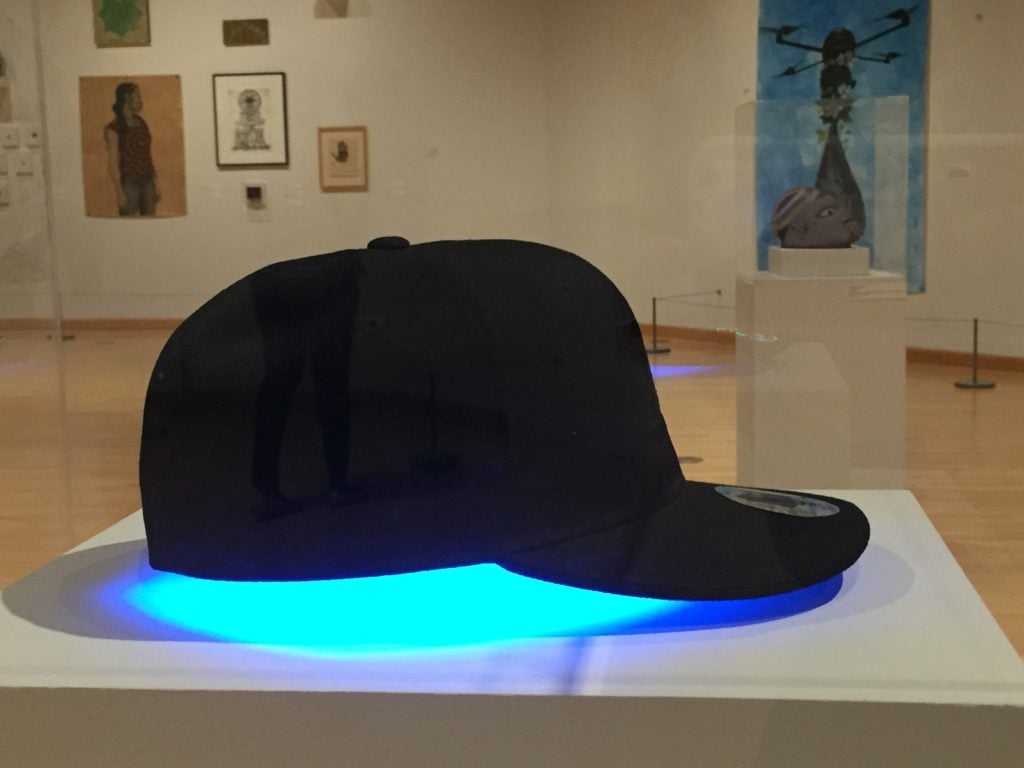
Robert Pruitt, Thinking Cap (2008). Photo courtesy Colony Little.
Throughout the show, Pruitt’s palette gravitates to red and blue. The color blue in particular appears to have some important symbolism in his sculpture Thinking Cap, where a blue LED light shines from underneath the brim of a black Malcolm X hat. The radiating color might evoke the ideas and theories percolating underneath.
Pruitt’s exploration of identity challenges present-day perceptions of race that have been shaped by Western culture. Positing that we can exist in a space free from perceptions that were built on concepts of stratification and subjugation, he illustrates what’s possible when we liberate ourselves from these damaging ideas using tools from the past and faith in the future.
In another sculptural piece, this one called Africa Then, a hardbound book on pre-colonial Africa rests precariously high atop a single white shelf, 10 feet above the gallery floor. Here, Pruitt reinforces the value of history and our collective knowledge of it: The book is beyond reach, but its presence suggests that our ability to move forward relies on the struggle to grasp our complicated past.
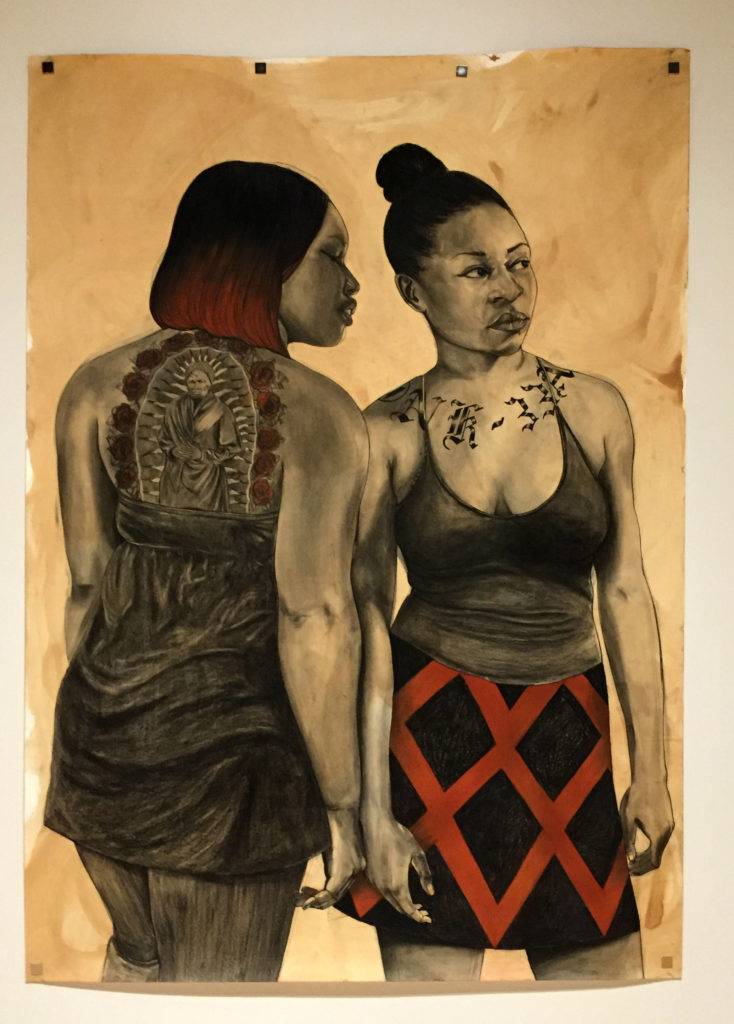
Robert Pruitt, Creator and Redeemer (2016). Photo courtesy Colony Little
Pruitt’s use of religious imagery placed alongside his historical and futuristic figures reemerges in Creator and Redeemer, a drawing featuring two young women who stand together, their bodies tattooed with an array of images that play on his different key themes.
The woman on the left has her back turned from the viewer, revealing an elaborate tattoo of Our Lady of Guadalupe that replaces the Virgin Mary with Harriet Tubman. The woman on the right sports a Chicanx-style collar bone tattoo in an Old English script. A little investigation reveals that they are a portion of the call letters for a Russian rocket engine. The juxtaposition of space travel with historical references becomes a metaphor for an escape toward freedom.
Compared to the brooding Communion, this particular work feels more forward looking. Whispering to each other in secret, Pruitt’s figures in Creator and Redeemer capture a clandestine moment that also reveals his subjects’ laser-focused, determined gaze towards whatever lies ahead.
Overall, in the new yet familiar universe Pruitt creates in his work, the fluidity of time frames and references subtly presents the viewer with important philosophical questions about how history operates. Can the past, present, and future exist in the same moment?
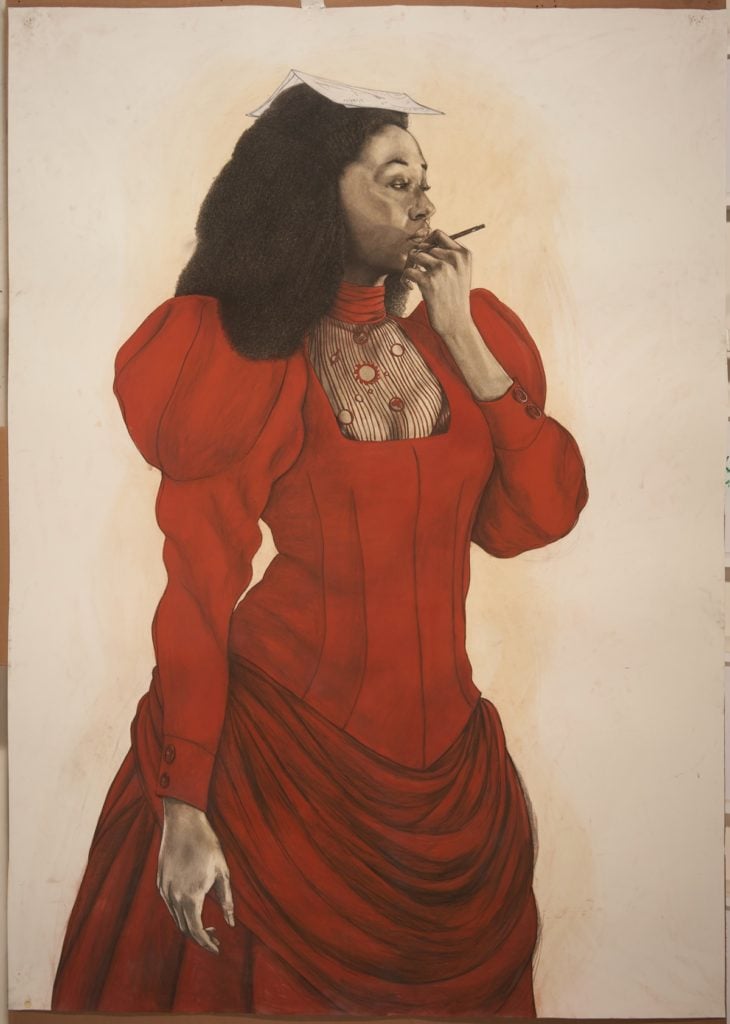
Robert Pruitt, Usher Board President (2018). Courtesy the artist and Koplin Del Rio Gallery.
Driving home this point in another way, “Devotion” also presents works of other artists that support Pruitt’s artistic vision here. Works selected from CAAM’s permanent collection hold court in the show, communing thematically as inspirational forebears. While similarities in style exist, particularly among works by Charles White and John Biggers, they are not totally used as artistic anchors that define the origins of the material in “Devotion.” Indeed, it feels more as if works by John Outterbridge and John T Riddle assume a new cultural relevance when re-framed within Pruitt’s contemporary artistic lens.
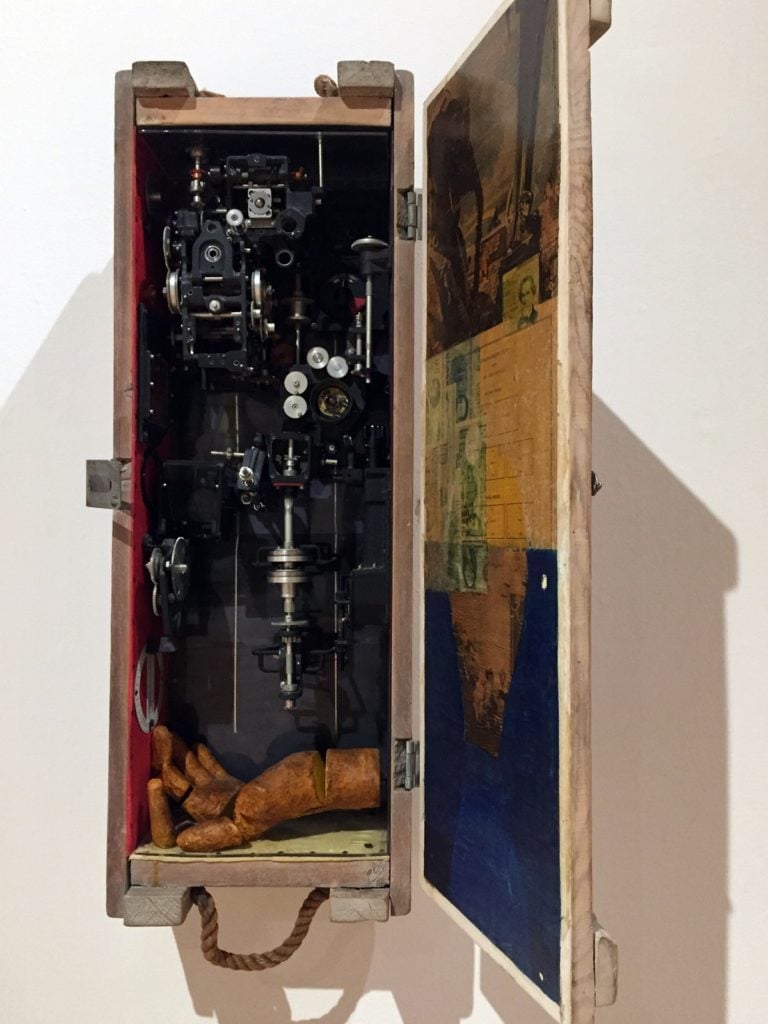
John T Riddle, Jr., Pieces at Hand, Spirit versus Technology Series (1973). Photo courtesy Colony Little.
The convergence of influences and styles in this show leaves the viewer with a lot of room for interpretation, yet Pruitt beautifully renders complex theories and religious themes into powerfully charged work that challenges us to think beyond what we see and experience in the present. His unwavering belief in “the substance of things unseen” is presented through references to fantasy and science fiction that link subtly to the symbols of faith. Pruitt’s figures honor the past, yet remain focused, powerfully, on a vision of the future.
“Robert Pruitt: Devotion” is on view at the California African American Museum, Los Angeles, through February 17, 2019.
Colony Little is the founder of Culture Shock Art.